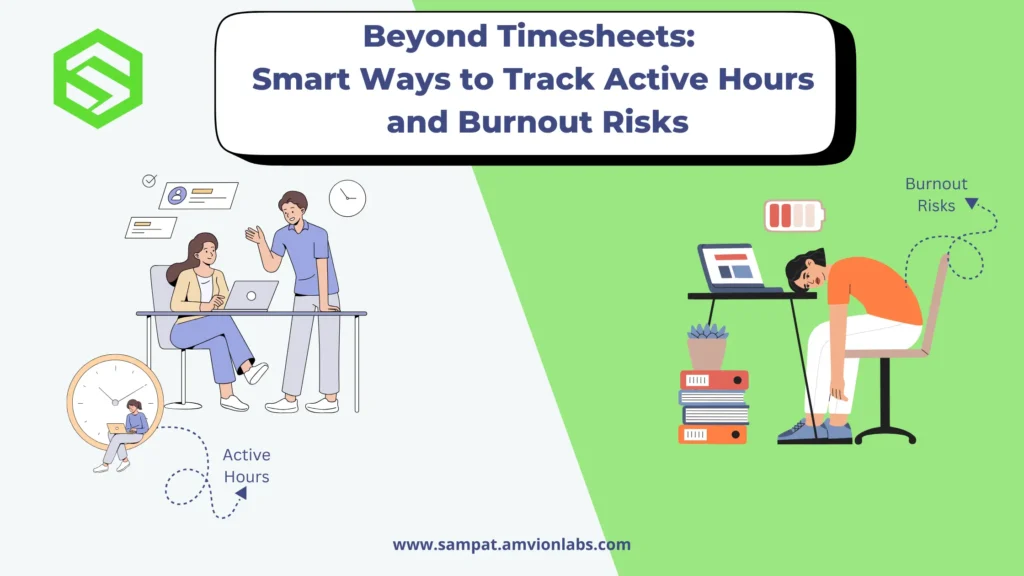
Beyond Timesheets: Smart Ways to Track Active Hours and Burnout Risks
Time tracking has long been a staple of workforce management—but the way we work has evolved, and so should the way we track it. With the rise of remote, hybrid, and asynchronous work models, businesses are realizing that traditional timesheets just don’t cut it anymore.
Yes, timesheets capture the “when” of work. But they rarely tell you how that time was spent, how productive it was, or whether your team is heading towards burnout.
That’s why it’s time to go beyond timesheets—to smarter systems that measure real engagement, active hours, and employee well-being. In this post, we’ll explore practical, data-driven strategies to help modern teams stay productive, healthy, and efficient using tools like SAMPAT employee productivity monitoring software.
Why Traditional Timesheets Are No Longer Enough
Timesheets served a purpose when work was tied to a fixed desk, in a 9-to-5 world, with managers watching from across the cubicle. But in 2025, the workplace is flexible, distributed, and digital.
Here’s why timesheets are falling short:
❌ They Rely on Manual Input
Employees often fill them at the end of the day (or week), relying on memory or guesswork—leading to inaccuracies.
❌ They Measure Time, Not Effort
Logging 8 hours doesn’t mean 8 hours of productivity. A lot of it could be idle or distracted time.
❌ They Miss Context
Was that 2-hour task efficient or dragged out due to fatigue? Timesheets won’t tell you.
❌ They Don’t Detect Burnout
If someone is working longer hours consistently, timesheets might applaud that—but smart systems would raise a flag.
Smarter, Data-Driven Ways to Track Work & Well-Being
Let’s dig into modern strategies that go beyond just logging hours—and instead focus on what’s happening during those hours and how your people are feeling.
1. Use Automated, Real-Time Activity Tracking
Manual timesheets are prone to human error. Automated systems like SAMPAT-PM track real-time digital activity—apps used, websites visited, idle time, keyboard/mouse usage, etc.—to reflect true active work time.
This method:
- Requires no manual input
- Increases accuracy
- Helps managers spot time-drains like distractions or non-work-related tasks
Example: If an employee logs 8 hours but was active only for 5, that’s a productivity red flag worth exploring.
2. Monitor for Burnout Risk Patterns
Burnout is a silent killer of productivity, morale, and retention. The earlier you can detect it, the better.
With intelligent analytics, SAMPAT-PM monitors:
- Unusually long work hours
- Lack of breaks
- Increasing idle time (a sign of disengagement)
- Declining task output
You get early signals like “Fatigue Risk Detected” so managers can initiate a check-in, shift workloads, or recommend time off.
3. Track Productivity Based on Output, Not Just Hours
In modern work, outcomes matter more than inputs. Measuring time alone doesn’t show productivity unless you relate it to task completion and goal progress.
SAMPAT-PM integrates with task tools (like Jira, Trello, ClickUp) to monitor how much value an employee creates per hour.
This helps:
- Recognize high performers
- Support those who need help
- Spot misaligned workloads
Real-world Use Case: An employee completes 4 high-impact tasks in 6 hours, while another logs 9 hours with minimal progress. Without output-based tracking, the first employee might be overlooked.
4. Encourage and Track Regular Breaks
Breaks aren’t laziness—they’re necessary for focus and recovery. Without monitoring, many remote workers overwork themselves unintentionally.
SAMPAT-PM allows:
- Scheduled break prompts
- Logged break tracking
- Patterns on work vs rest ratios
This fosters a healthy, human-friendly work culture—especially important for teams working long hours or late shifts.
5. Use Behavioral Data to Personalize Workflows
Every employee works differently. Some are early birds, some are night owls. Some peak in focus mid-morning, others after lunch.
Advanced tracking tools can help managers:
- Identify individual productivity zones
- Suggest optimal schedules
- Avoid micromanagement while still improving efficiency
With SAMPAT, you can visualize when your team is most focused, helping schedule important tasks during high-performance windows.
6. Leverage Dashboard Visuals for Fast, Actionable Insights
Raw data can be overwhelming. That’s why SAMPAT presents it in clean, customizable dashboards—so managers and HR leaders can:
- View weekly/monthly active hour trends
- Analyze team productivity vs burnout risks
- Filter by team, department, or individual
- Export reports for reviews and compliance
No guesswork. Just decisions backed by real-time data.
How SAMPAT Goes Beyond Timesheets
SAMPAT is not just another time tracker. It’s a complete employee productivity monitoring platform designed to:
- Track active hours with precision
- Detect early burnout risks
- Provide visual productivity insights
- Enable remote/hybrid workforce efficiency
- Promote employee well-being with balance-driven tracking
Whether you’re an HR leader, project manager, or CEO—SAMPAT offers the clarity you need to lead smarter and support better.
Business Benefits of Smarter Time and Productivity Tracking
Final Thoughts
The workplace is changing—and so should the tools we use to manage it. Timesheets were a start, but they can’t keep up with the complexity of modern work.
What we need now are systems that look beyond time—into attention, engagement, output, and wellness.
With SAMPAT-PM, you don’t just track time—you track what truly matters.
Let’s move beyond timesheets. Let’s build smarter, healthier teams.



